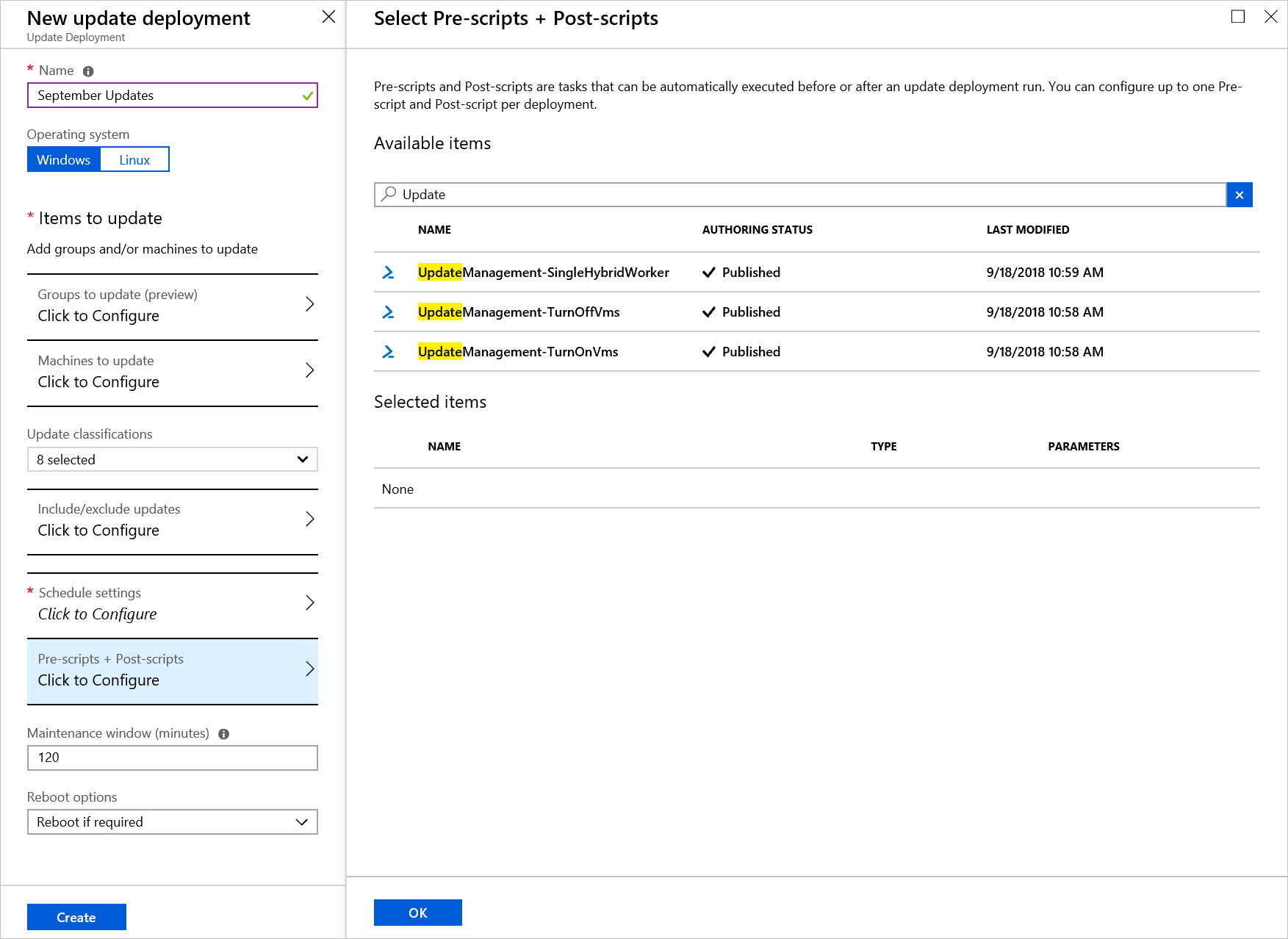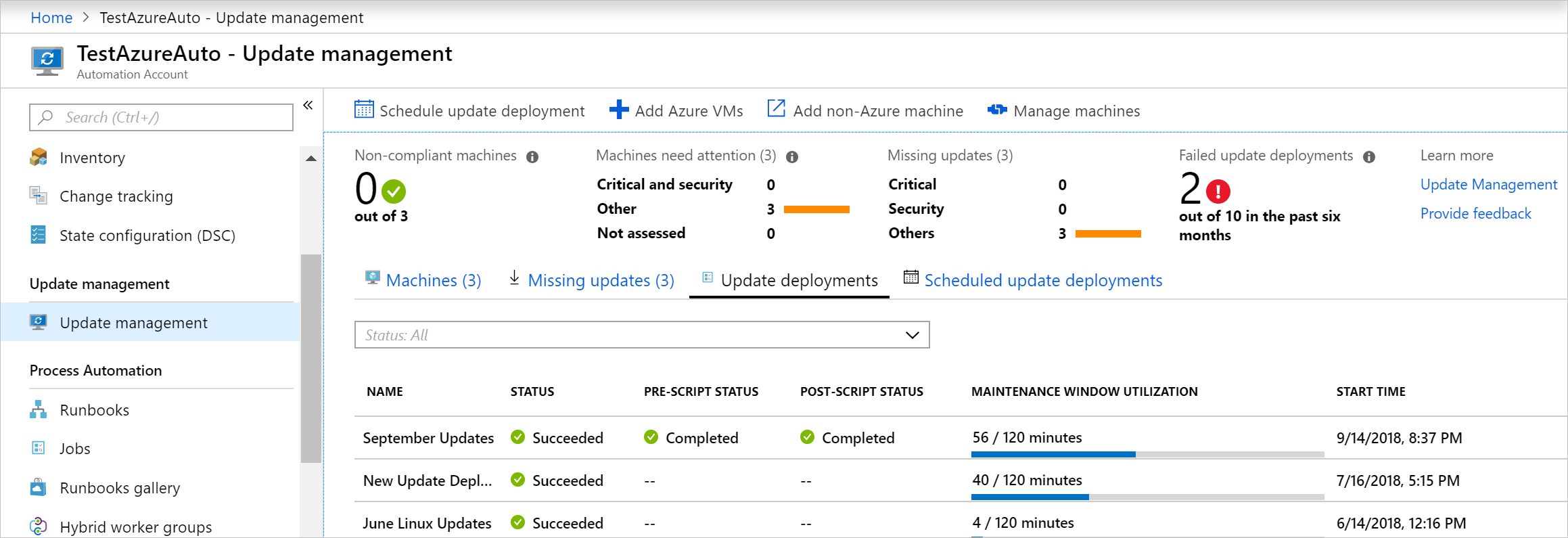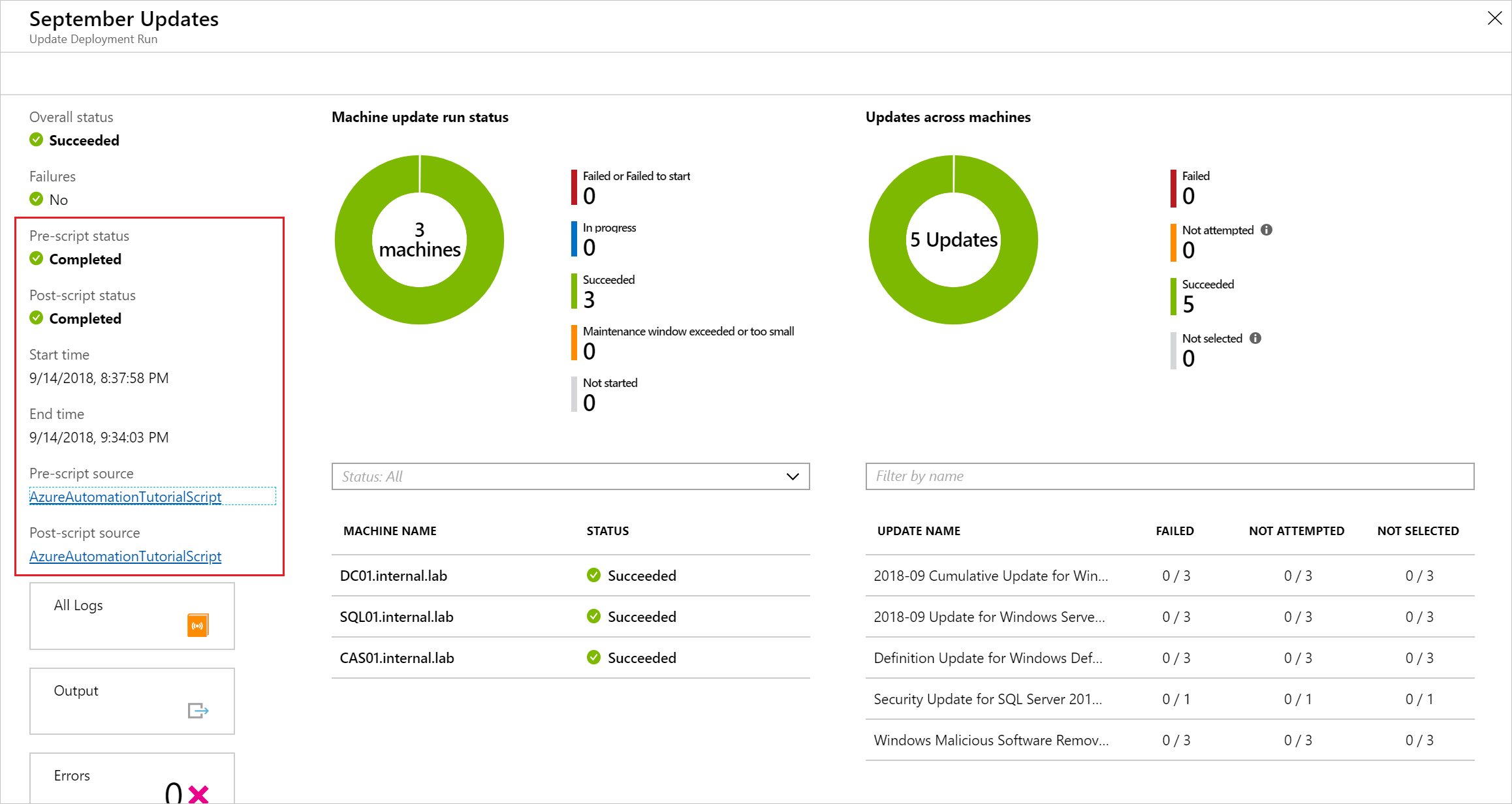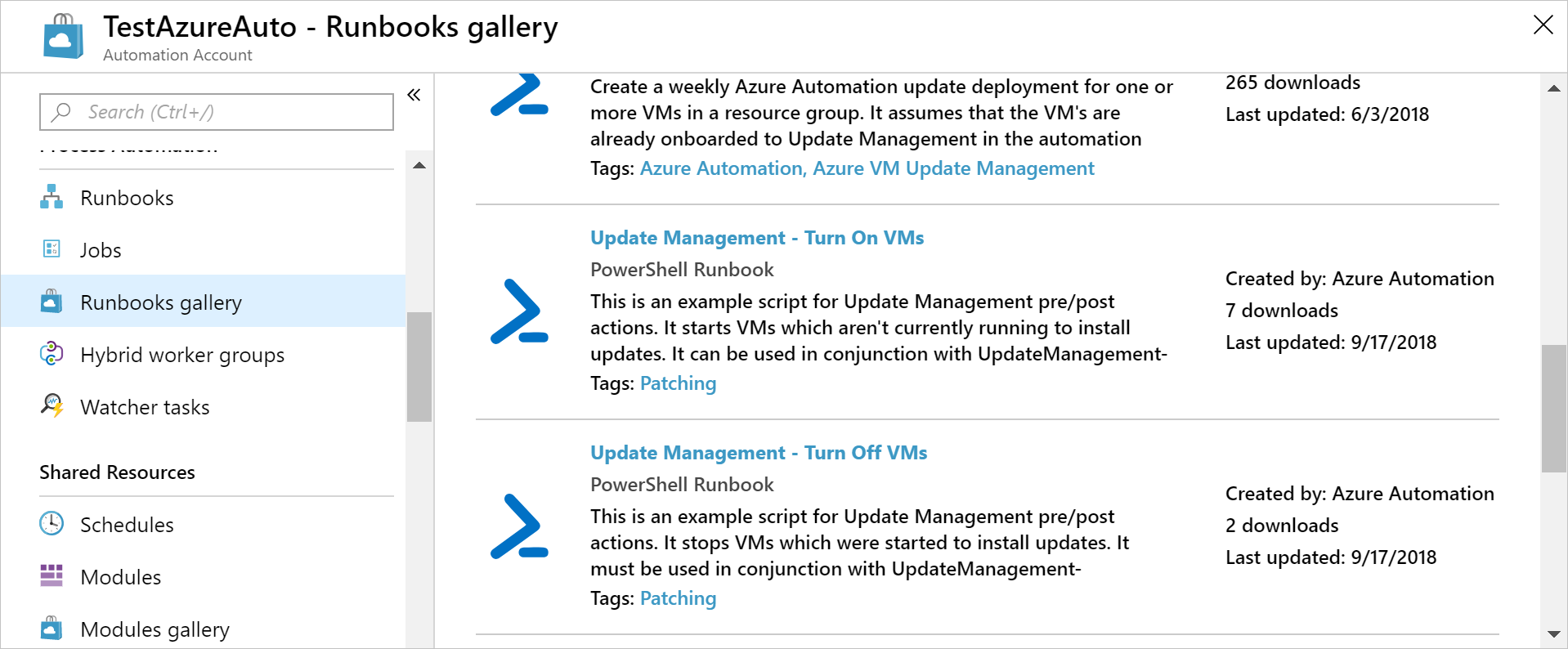你当前正在访问 Microsoft Azure Global Edition 技术文档网站。 如果需要访问由世纪互联运营的 Microsoft Azure 中国技术文档网站,请访问 https://docs.azure.cn。
管理前脚本和后脚本
重要
自动化更新管理已于 2024 年 8 月 31 日停用,我们建议使用 Azure 更新管理器。 请遵循从自动化更新管理迁移到 Azure 更新管理器的指南。
操作前脚本和操作后脚本是在执行更新部署之前(执行任务前)和之后(执行任务后)要在 Azure 自动化帐户中运行的 runbook。 操作前脚本和操作后脚本在 Azure 上下文中运行,而不是在本地运行。 操作前脚本在更新部署开始时运行。 在 Windows 上,后脚本在部署结束时和任何配置的重新启动后运行。 对于 Linux,后脚本在部署结束后(而不是在计算机重新启动后)运行。
操作前脚本和操作后脚本要求
若要将某个 runbook 用作操作前脚本或操作后脚本,必须将其导入到自动化帐户中并发布 runbook。
目前仅支持将 PowerShell 5.1 和 Python 2 runbook 作为前期/后期脚本。 目前不支持将其他 runbook 类型(如 Python 3、图形、PowerShell 工作流和图形 PowerShell 工作流)作为前期/后期脚本。
操作前脚本和操作后脚本参数
配置操作前脚本和操作后脚本时,可以像计划 runbook 时一样传入参数。 参数是在创建更新部署时定义的。 操作前脚本和操作后脚本支持以下类型:
- [char]
- [byte]
- [int]
- [long]
- [decimal]
- [single]
- [double]
- [DateTime]
- [string]
操作前脚本和操作后脚本 runbook 参数不支持布尔值、对象或数组类型。 这些值会导致 runbook 失败。
如果需要其他对象类型,可以在 runbook 中使用自己的逻辑将它强制转换为其他类型。
除标准 runbook 参数外,还提供 SoftwareUpdateConfigurationRunContext 参数(类型为 JSON 字符串)。 如果在操作前脚本或操作后脚本 runbook 中定义该参数,更新部署会自动传入该参数。 该参数包含有关更新部署的信息,这是 SoftwareUpdateconfigurations API 返回的信息的子集。 以下部分定义关联的属性。
SoftwareUpdateConfigurationRunContext 属性
| 属性 | 类型 | 说明 |
|---|---|---|
| SoftwareUpdateConfigurationName | 字符串 | 软件更新配置的名称。 |
| SoftwareUpdateConfigurationRunId | GUID | 运行的唯一 ID。 |
| SoftwareUpdateConfigurationSettings | 与软件更新配置相关的属性的集合。 | |
| SoftwareUpdateConfigurationSettings.OperatingSystem | int | 面向更新部署的操作系统。 1 = Windows,2 = Linux |
| SoftwareUpdateConfigurationSettings.Duration | 时间跨度 (HH:MM:SS) | 符合 ISO8601 的更新部署运行的最长持续时间,格式为 PT[n]H[n]M[n]S;也称为“维护时段”。示例:02:00:00 |
| SoftwareUpdateConfigurationSettings.WindowsConfiguration | 与 Windows 计算机相关的属性的集合。 | |
| SoftwareUpdateConfigurationSettings.WindowsConfiguration.excludedKbNumbers | 字符串 | 从更新部署中排除的知识库的空格分隔列表。 |
| SoftwareUpdateConfigurationSettings.WindowsConfiguration.includedKbNumbers | 字符串 | 更新部署中包含的知识库的空格分隔列表。 |
| SoftwareUpdateConfigurationSettings.WindowsConfiguration.UpdateCategories | 整数 | 1 =“关键”; 2 =“安全” 4 =“更新汇总” 8 =“功能包” 16 =“服务包” 32 =“定义” 64 =“工具” 128 =“更新” |
| SoftwareUpdateConfigurationSettings.WindowsConfiguration.rebootSetting | 字符串 | 更新部署的重新启动设置。 值为 IfRequired、Never、Always |
| SoftwareUpdateConfigurationSettings.LinuxConfiguration | 与 Linux 计算机相关的属性集合。 | |
| SoftwareUpdateConfigurationSettings.LinuxConfiguration.IncludedPackageClassifications | 整数 | 0 =“未分类” 1 =“关键” 2 =“安全” 4 =“其他” |
| SoftwareUpdateConfigurationSettings.LinuxConfiguration.IncludedPackageNameMasks | 字符串 | 更新部署中包含的包名称的空格分隔列表。 |
| SoftwareUpdateConfigurationSettings.LinuxConfiguration.ExcludedPackageNameMasks | 字符串 | 从更新部署中排除的包名称的空格分隔列表。 |
| SoftwareUpdateConfigurationSettings.LinuxConfiguration.RebootSetting | 字符串 | 更新部署的重新启动设置。 值为 IfRequired、Never、Always |
| SoftwareUpdateConfigurationSettings.AzureVirtualMachines | 字符串数组 | 更新部署中 Azure VM 的 resourceId 的列表。 |
| SoftwareUpdateConfigurationSettings.NonAzureComputerNames | 字符串数组 | 更新部署中的非 Azure 计算机 FQDN 的列表。 |
以下示例是传递给 Linux 计算机的 SoftwareUpdateConfigurationSettings 属性的 JSON 字符串:
"SoftwareUpdateConfigurationSettings": {
"OperatingSystem": 2,
"WindowsConfiguration": null,
"LinuxConfiguration": {
"IncludedPackageClassifications": 7,
"ExcludedPackageNameMasks": "fgh xyz",
"IncludedPackageNameMasks": "abc bin*",
"RebootSetting": "IfRequired"
},
"Targets": {
"azureQueries": null,
"nonAzureQueries": ""
},
"NonAzureComputerNames": [
"box1.contoso.com",
"box2.contoso.com"
],
"AzureVirtualMachines": [
"/subscriptions/aaaa0a0a-bb1b-cc2c-dd3d-eeeeee4e4e4e/resourceGroups/resourceGroupName/providers/Microsoft.Compute/virtualMachines/vm-01"
],
"Duration": "02:00:00",
"PSComputerName": "localhost",
"PSShowComputerName": true,
"PSSourceJobInstanceId": "2477a37b-5262-4f4f-b636-3a70152901e9"
}
以下示例是传递给 Windows 计算机的 SoftwareUpdateConfigurationSettings 属性的 JSON 字符串:
"SoftwareUpdateConfigurationRunContext": {
"SoftwareUpdateConfigurationName": "sampleConfiguration",
"SoftwareUpdateConfigurationRunId": "00000000-0000-0000-0000-000000000000",
"SoftwareUpdateConfigurationSettings": {
"operatingSystem": "Windows",
"duration": "02:00:00",
"windows": {
"excludedKbNumbers": [
"168934",
"168973"
],
"includedUpdateClassifications": "Critical",
"rebootSetting": "IfRequired"
},
"azureVirtualMachines": [
"/subscriptions/aaaa0a0a-bb1b-cc2c-dd3d-eeeeee4e4e4e/resourceGroups/myResourceGroup/providers/Microsoft.Compute/virtualMachines/vm-01",
"/subscriptions/aaaa0a0a-bb1b-cc2c-dd3d-eeeeee4e4e4e/resourceGroups/myResourceGroup/providers/Microsoft.Compute/virtualMachines/vm-02",
"/subscriptions/aaaa0a0a-bb1b-cc2c-dd3d-eeeeee4e4e4e/resourceGroups/myResourceGroup/providers/Microsoft.Compute/virtualMachines/vm-03"
],
"nonAzureComputerNames": [
"box1.contoso.com",
"box2.contoso.com"
]
}
}
可以在以下位置找到包含所有属性的完整示例:按名称获取软件更新配置。
注意
SoftwareUpdateConfigurationRunContext 对象可以包含计算机的重复项。 这可能导致操作前脚本和操作后脚本在同一计算机上多次运行。 若要解决此问题,请使用 Sort-Object -Unique 仅选择唯一 VM 名称。
在部署中使用操作前脚本或操作后脚本
若要在更新部署中使用操作前脚本或操作后脚本,请先创建一个更新部署。 选择“操作前脚本 + 操作后脚本”。 此操作会打开“选择前脚本 + 后脚本”页面。

选择要使用的脚本。 在此示例中,我们使用 UpdateManagement-TurnOnVms runbook。 选择 runbook 后,“配置脚本”页会打开。 选择“操作前脚本”,然后选择“确定”。
针对 UpdateManagement-TurnOffVms 脚本重复此过程。 但是,选择“脚本类型”时,请选择“操作后脚本”。
“选定项”部分现在显示选择的两个脚本。 一个是操作前脚本,另一个是操作后脚本:

完成更新部署的配置。
更新部署完成后,可以转到“更新部署”查看结果。 可以看到,此处提供了操作前脚本和操作后脚本的状态:

通过选择更新部署运行,系统将显示操作前脚本和操作后脚本的其他详细信息。 此时会提供运行时的脚本源的链接。

停止部署
如果要停止基于操作前脚本的部署,则必须引发异常。 否则,仍将运行部署和操作后脚本。 以下代码片段演示如何使用 PowerShell 引发异常。
#In this case, we want to terminate the patch job if any run fails.
#This logic might not hold for all cases - you might want to allow success as long as at least 1 run succeeds
foreach($summary in $finalStatus)
{
if ($summary.Type -eq "Error")
{
#We must throw in order to fail the patch deployment.
throw $summary.Summary
}
}
在 Python 2 中,异常处理是在 try 块中进行管理的。
与计算机交互
前期脚本和后期脚本在自动化帐户中作为 Runbook 运行,而不是直接在部署中的计算机上运行。 执行前任务和执行后任务也在 Azure 上下文中运行,并且无权访问非 Azure 计算机。 以下部分演示如何直接与计算机交互,而无论它们是 Azure VM 还是非 Azure 计算机。
与 Azure 计算机交互
执行前任务和执行后任务作为 runbook 运行,而不是在部署中的 Azure VM 本机上运行。 若要与 Azure VM 交互,必须具有以下各项:
- 托管标识或运行方式帐户
- 要运行的 runbook
若要与 Azure 计算机交互,应使用 Invoke-AzVMRunCommand cmdlet 与 Azure VM 进行交互。 有关如何执行此操作的示例,请参阅 runbook 示例更新管理 - 使用 Run 命令运行脚本。
与非 Azure 计算机交互
执行前任务和执行后任务在 Azure 上下文中运行,并且无权访问非 Azure 计算机。 若要与非 Azure 计算机交互,必须具有以下项:
- 托管标识或运行方式帐户
- 在计算机上安装的混合 Runbook 辅助角色
- 要在本地运行的 Runbook
- 父 runbook
若要与非 Azure 计算机交互,需在 Azure 上下文中运行父 runbook。 此 runbook 使用 Start-AzAutomationRunbook cmdlet 调用子 runbook。 必须指定 RunOn 参数,并提供运行脚本的混合 Runbook 辅助角色的名称。 请参阅 runbook 示例更新管理 - 在本地运行脚本。
中止修补程序部署
如果操作前脚本返回错误,则可能需要中止部署。 为此,必须在脚本中为可能导致失败的所有逻辑的引发错误。
if (<My custom error logic>)
{
#Throw an error to fail the patch deployment.
throw "There was an error, abort deployment"
}
在 Python 2 中,如果要在发生特定状况时引发错误,请使用 raise 语句。
If (<My custom error logic>)
raise Exception('Something happened.')
示例
可以在 Azure 自动化 GitHub 组织和 PowerShell 库中找到操作前脚本和操作后脚本的示例,也可以通过 Azure 门户导入这些示例。 为此,请在自动化帐户的“流程自动化”下,选择“Runbook 库”。 使用“更新管理”作为筛选器。

或者,可按脚本名称进行搜索,如以下列表中所示:
- 更新管理 - 启用 VM
- 更新管理 - 禁用 VM
- 更新管理 - 本地运行脚本
- 更新管理 - 前脚本/后脚本的模板
- 更新管理 - 具有 Run 命令运行脚本
重要
导入 runbook 后,必须先发布,然后才可以使用它们。 为此,请在自动化帐户中找到该 runbook,选择“编辑”,然后选择“发布” 。
所有这些示例均基于以下示例中定义的基本模板。 使用此模板可以创建自己的 runbook 来配合操作前脚本和操作后脚本。 其中还包含用于在 Azure 中进行身份验证以及处理 SoftwareUpdateConfigurationRunContext 参数所需的逻辑。
<#
.SYNOPSIS
Barebones script for Update Management Pre/Post
.DESCRIPTION
This script is intended to be run as a part of Update Management pre/post-scripts.
It requires the Automation account's system-assigned managed identity.
.PARAMETER SoftwareUpdateConfigurationRunContext
This is a system variable which is automatically passed in by Update Management during a deployment.
#>
param(
[string]$SoftwareUpdateConfigurationRunContext
)
#region BoilerplateAuthentication
# Ensures you do not inherit an AzContext in your runbook
Disable-AzContextAutosave -Scope Process
# Connect to Azure with system-assigned managed identity
$AzureContext = (Connect-AzAccount -Identity).context
# set and store context
$AzureContext = Set-AzContext -SubscriptionName $AzureContext.Subscription -DefaultProfile $AzureContext
#endregion BoilerplateAuthentication
#If you wish to use the run context, it must be converted from JSON
$context = ConvertFrom-Json $SoftwareUpdateConfigurationRunContext
#Access the properties of the SoftwareUpdateConfigurationRunContext
$vmIds = $context.SoftwareUpdateConfigurationSettings.AzureVirtualMachines | Sort-Object -Unique
$runId = $context.SoftwareUpdateConfigurationRunId
Write-Output $context
#Example: How to create and write to a variable using the pre-script:
<#
#Create variable named after this run so it can be retrieved
New-AzAutomationVariable -ResourceGroupName $ResourceGroup -AutomationAccountName $AutomationAccount -Name $runId -Value "" -Encrypted $false
#Set value of variable
Set-AutomationVariable -Name $runId -Value $vmIds
#>
#Example: How to retrieve information from a variable set during the pre-script
<#
$variable = Get-AutomationVariable -Name $runId
#>
如果希望 Runbook 使用系统分配的托管标识执行,请按原样保留代码。 如果希望使用用户分配的托管标识,则执行以下操作:
- 从第 22 行中删除
$AzureContext = (Connect-AzAccount -Identity).context, - 将其替换为
$AzureContext = (Connect-AzAccount -Identity -AccountId <ClientId>).context,然后 - 输入客户端 ID。
注意
对于非图形 PowerShell runbook,Add-AzAccount 和 Add-AzureRMAccount 是 Connect-AzAccount 的别名。 可以使用这些 cmdlet,也可以在自动化帐户中将模块更新为最新版本。 即使刚刚创建了一个新的自动化帐户,也可能需要更新你的模块。
后续步骤
有关更新管理的详细信息,请参阅管理 VM 的更新和修补程序。